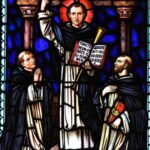
St. Mary Magdalene
St. Mary Magdalene
When They Lived:
St. Mary Magdalene, often referred to as the “Apostle to the Apostles,” lived during the 1st century AD. While the exact dates of her birth and death are not definitively known, historical and religious texts suggest she was born around 1st century BCE and passed away around 1st century CE.
Where They Lived:
St. Mary Magdalene hailed from the town of Magdala, situated on the western shore of the Sea of Galilee in ancient Judea. This picturesque fishing village was nestled among rolling hills and held significant importance as a trade and cultural center.
Notable World Events During the Time of Their Life:
- Roman Conquest of Britain (43 AD): The Roman Empire expanded its dominion by conquering Britain, leading to the establishment of Roman rule on the island and shaping its cultural and political landscape for centuries.
- The Great Fire of Rome (64 AD): The infamous fire that ravaged Rome during the reign of Emperor Nero resulted in widespread destruction. This event also marked the beginning of Nero’s persecution of Christians, which could have directly affected St. Mary Magdalene and other early Christians.
- Boudica’s Revolt (60-61 AD): Boudica, queen of the Iceni tribe in Britain, led a rebellion against Roman forces in response to oppressive Roman rule. Her actions left a lasting impact on British history and the struggle for independence.
- Pompeii and Herculaneum Destruction (79 AD): The catastrophic eruption of Mount Vesuvius buried the Roman cities of Pompeii and Herculaneum under layers of ash and pumice, preserving a snapshot of daily life in ancient Rome and its colonies.
- Foundation of the Flavian Dynasty (69-96 AD): The Flavian emperors Vespasian, Titus, and Domitian succeeded in restoring stability to the Roman Empire after the tumultuous Year of the Four Emperors, ushering in a new era of Roman leadership.
- Han Dynasty Collapse and Three Kingdoms Period (220 AD): In China, the once-mighty Han Dynasty crumbled, leading to a period of fragmentation and warfare known as the Three Kingdoms Period. This era would have a profound impact on the country’s cultural and political evolution.
Their Patronage:
St. Mary Magdalene is revered as the patron saint of a diverse array of causes. She is often invoked as a protector against temptation, making her an emblem of spiritual transformation and redemption. Moreover, she is the patroness of women, particularly those seeking solace from personal struggles or seeking guidance on their spiritual journeys. Her association with perfumery and aromatic oils also makes her the patron saint of perfumers and those who work with fragrances.
A Subject of Theories
The Sacred Scriptures have mentioned plenty of women who played important roles in the whole history of salvation. Of course, the Blessed Virgin Mary is exalted among all women for being chosen as the Mother of Jesus Christ, the Redeemer of humanity. Another of the most prominent women mentioned in the New Testament was Mary Magdalene.
As her name implies, Mary lived in the town of Magdala, a prosperous fishing village, at the time Jesus was active in this region. It was also a place where Jesus spent much of His time preaching. This was the place where Mary probably first encountered Jesus.
Mary Magdalene has become the subject of many theories in the New Testament. Some think that she might be the unnamed woman who entered Simon the Pharisee’s house, bringing an alabaster jar of costly perfume, and “stood behind him at his feet weeping and began to bathe his feet with her tears. Then she wiped them with her hair, kissed them, and anointed them with the ointment.” (Luke 7:38). Some say that she was the sister of Martha and Lazarus of Bethany (see John 11:1-44). Others say, and this is most probably what Mary Magdalene was known for until today, that she was the unknown woman who was caught in adultery (see John 8:2-11).
What the Gospels Say
But what is clear in the Gospel is that Mary Magdalene was one of the Galilean women who followed Jesus. To be more precise, she was the woman who “had been cured of evil spirits and infirmities… from whom seven demons had gone out” (Luke 8:2). Nothing is sure about what these “demons” were, but over the centuries, many scholars have guessed that she was an immoral woman. The Church has said this is not so, while many Scripture experts believe that the reference means she was cured of illness by Christ.
What seemed ironic was that Jesus chose the Twelve Apostles. In the face of His suffering and death, they all left Him, except John. The Gospels speak of women who were present during Jesus’ passion. Matthew recounts that there were “many women there, looking on from a distance, who had followed Jesus from Galilee, ministering to him.” (27:55). Mark provided details of who these women were: “There were also women looking on from a distance. Among them were Mary Magdalene, Mary the mother of the younger James and of Joses, and Salome.” (15:40)
But the Gospel according to John even mentioned that she was at the foot of Jesus’ cross: “Standing by the cross of Jesus were his mother and his mother’s sister, Mary the wife of Clopas, and Mary of Magdala.” (John 19:25). And to complete the details, according to Mark, Mary Magdalene was present when Jesus was laid in the tomb: “Mary Magdalene and Mary the mother of Joses watched where he was laid.” (Mark 15:47).
The First to See the Risen Christ
The Gospels all agree that Mary Magdalene was the first person to see the Resurrected Christ (see Matthew 28:1; Mark 16:9; Luke 24:10; John 20:1). The Gospel according to John provided more details about Mary Magdalene’s encounter with the Risen Jesus than the other three Gospels.

Nothing is known about where Mary Magdalene went after Jesus ascended into heaven. Tradition says that she went with the Apostle John to Ephesus. Others say she went to southern France, where she lived in solitude in a cave and prayed. Her feast day is celebrated on July 22.
Five Interesting Facts About St. Mary Magdalene
- St. Mary Magdalene is known as “Apostola Apostolorum” or the “Apostle to the Apostles”. According to John 20:17, the Risen Jesus instructed and sent her to tell the Apostles that He was ascending to God.
- St. Mary Magdalene’s name is mentioned twelve different times in the Bible.
- Pope Gregory the Great referred to Mary Magdalene’s deliverance from the seven demons, inferring that they were the seven deadly sins talked about in the Bible, which include lust, gluttony, greed, sloth, wrath, envy, and pride.
- St. Mary Magdalene is the patron saint of converts, women, penitents, contemplation, and sexual temptation.
- According to French legend, St. Mary Magdalene is alleged to have converted the king and queen of Gaul and evangelized the Franks, thus becoming the Apostle of France.
Prayer to St. Mary Magdalene
O God, whose Only Begotten Son entrusted Mary Magdalene before all others with announcing the great joy of the Resurrection,grant, we pray,that through her intercession and example we may proclaim the living Christ and come to see him reigning in your glory. Who lives and reigns with you in the unity of the Holy Spirit,one God, for ever and ever. Amen.



